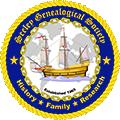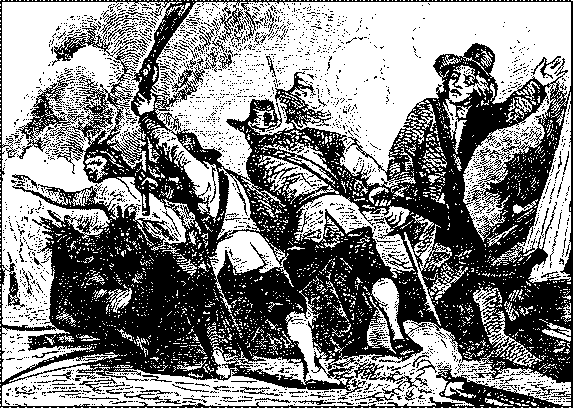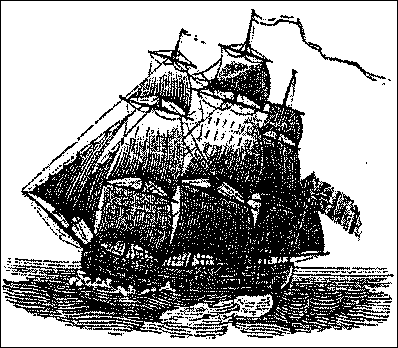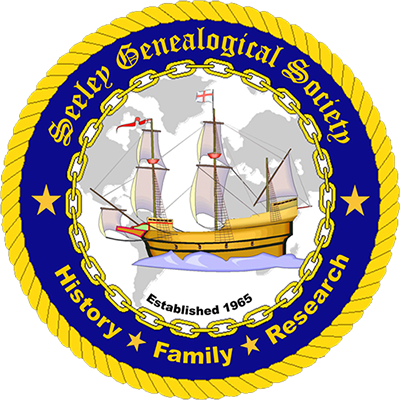The Pequot War was the first serious armed conflict between indigenous people and settlers in New England. Robert Seeley fought alongside Captain Robert Mason and was wounded in battle.
What We Know About Robert Seeley
Recently, my sister-in-law asked me what was so special about Robert that I would travel across the country to attend the SGS Reunion. I have thought a lot about this and I realize that there is nothing so remarkable about Robert except that this organization exists to remember him and his accomplishments. He was not rich or famous, but he was a hard working, dependable man. He was resourceful, able to fill several roles. He was trained as a cordswainer, a type of shoemaker, but he also functioned as a surveyor and a soldier. I see him as handsome and strong. He had one little boy, Nathaniel, and now a posterity that probably numbers in the millions, many with the same characteristics as Robert.
Robert and the Winthrop Fleet
Dian Little secured a copy of the book, The Hearth and the Eagle by Anya Seton and lent it to me. This book was published in 1948 so it is certainly not a new publication but I had never read it before. It is a work of fiction which follows several generations but begins with a young couple, Phoebe and Mark Honeywood, much like our Robert and Mary, as members of the Winthrop Fleet. In the author’s note, we read, “I am particularly indebted to… Governor Winthrop’s own careful, detailed journal in which I was able to follow the day-by-day incidents of that historic voyage.” I learned that not all of the travelers were Puritans, but many came to seek a new life for themselves and their families. I could visualize our newly wed couple, Robert and Mary, as I read.
I see Robert as a strong, hard working, steady influence for good among the passengers of the Winthrop Fleet. There is an organization for descendants of passengers of the Winthrop Fleet. Are any of you members of The Winthrop Society? I am hoping someone will be willing to be an active member of that group and represent Robert and Mary and report to SGS on your findings.
Robert as an Adventurer
How many of you love to travel and see new things? I know I do. I think we inherited this characteristic from Robert. My grandmother Merrill, a Seely by birth, did not need any persuasion when confronted with the opportunity to travel. She could be ready in a minute, with her little grey traveling bag and a hat, off she went! Robert was off on new adventures all his life! He left his native Huntingdonshire to take up an apprenticeship in London. He left that life to join the Winthrop Fleet and come to the new world.
He settled in Watertown, Mass. in 1630 but left again to accompany John Oldham to scout out a new home in the wilderness as early as 1633. He was among the founders, known as “The Ten Adventurers,” of Wethersfield, Conn. In 1637, he participated, as second in command to Captain John Mason, in the Pequot Wars. He carried a scar for the rest of his life. He left Wethersfield to help establish the “Quinipiac Colony” which was later known as New Haven Colony, which was founded by John Davenport, the minister from St. Stephen’s Church, Coleman Street, in London. In 1651, apparently after the death of his wife, Mary, he embarked on new adventures. He served as the Captain of New Haven Forces fighting the Dutch and the Indians on Long Island. He returned to England. In 1662, he was appointed Commissioner for the town of Huntington, Long Island. He and others settled Elizabeth, N.J. in 1665. He married again in 1666 to Mary Manning Walker and apparently lived on Manning’s Island (now known as Roosevelt Island) in the East River where we believe he died in 1667 or 1668. Quite a life of adventure!
Was the trip to Wethersfield by land or by water?
There had been a question in my mind about the trip from Watertown in Massachusetts Colony to the Wethersfield settlement on the Connecticut River. Did Robert, Mary and Nathaniel go by land or by water? In reading The River Towns of Connecticut by Charles M. Andrews we learn that the Pequot Indians had invaded the Connecticut shore and were making war on the weaker Indian tribes who lived along the Connecticut River. The weaker tribes sent envoys to both the Plymouth Colony and the Watertown settlement to ask the Englishmen to come to their rescue. The Plymouth Group sent a party who went through the Long Island Sound and up the Connecticut River and settled the area that is now known as Windsor. The Dutch had also established a trading post in the area of present day Hartford. In The History of Ancient Wethersfield by Henry R. Stiles, it states “John Oldham and three with him went overland to Connecticut to trade, the Sacham (Indian leader) used them kindly, and gave them some beaver, and they brought of the hemp which grew there.” This is taken from the journal of Governor Winthrop. Perhaps Robert was one of the three who went along on this expedition but in any case the journey was overland along Indian trails.
Robert Seeley’s role in Wethersfield
We read the following from The History of Ancient Wethersfield: “3. (In the list of Adventurers) Sergeant (afterwards Lieutenant) Robert Seeley was also an owner of “adventure land.” Although it appears that he held “as an adventurer” under William Bassum (or Bassam) it is quite probable that the latter only held possession during Mr. Seeley’s absence at Watertown, Mass., where he was finishing some work (principally surveying), which he had been employed to do there. Bond (author of History of Watertown) quite ignores him, and Savage fails to trace him any farther than Watertown. Lt. Seeley, however, was a prominent man in the Colony, notably in the Pequot campaign, in which he was second in command; and also, later, as commandant of the fort at Saybrook. He was a near neighbor of Finch, on the east side of Broad Street in Wethersfield, and sold his house to Matthew Mitchell in 1640-1.”
The Pequot War vs. The Massacre at Mystic
Because of Robert Seeley’s involvement in the Pequot War, I was very interested when the History Channel ran a series called 10 Days that Unexpectedly Changed America. The first day highlighted was May 26, 1637, the day when Robert and the other colonists burned the village of Mystic and killed an estimated 400-700 Pequot villagers. The other members of the Pequot tribe escaped to other villages but most of them were eventually killed, or captured and given as slaves to tribes friendly to the English. The Pequot Indians were fierce, aggressive and unwilling to negotiate peace. Several settlers of Wethersfield and surrounding area were killed in skirmishes with the Pequots. Other Indian tribes were terrorized by the Pequots and they joined the English to defeat them. The colonists believed that for their own defense it was necessary to destroy these Indians. The colonists (estimated at 250 men who could bear arms) were greatly outnumbered by the Pequot warriors (estimated at 2000). At the conclusion of the Pequot War, it was believed that the Pequot Indians were eliminated.
This video production was filmed at Plimouth Plantation and it is very beautifully done. As I viewed the video, however, I realized that I was hearing about this event from a different perspective. From a flyer for this video, we read, “On May 26, 1637, the long simmering culture clash between English settlers and the powerful and expansionist Pequot Indians in the Connecticut River Valley boiled over as the settlers brutally attacked a Pequot encampment, leaving hundreds of men, women and children dead. Known as the Pequot War, this was the first time the English settlers engaged in a major battle with Native Americans after years of relative peaceful coexistence. This massacre in Mystic, Conn. set the pattern of the taking of Indian land throughout the country.” The Pequots, whom the early settlers thought they had destroyed, have become a very wealthy, political power by the establishment of a very successful casino in Connecticut. Apparently, with money and political power, it is possible to change history or at least the interpretation of history.
Was Robert a hero or not?
I guess it depends on your perspective.
Can we locate records of Robert Seeley’s stay in England?
Robert apparently returned to England in 1655 and stayed until 1661-2. On Nov. 22, 1659, Nathaniel Seeley of Fairfield, Connecticut, “a son of Robert Seeley in England,” sold land that was his father’s. It might prove interesting to know where he was in England and what he was doing. This should be a topic of research.
Where and when did Robert Seeley die?
Another topic needing to be researched concerns Robert’s death. SGS publication, Descendants of Robert Seeley (SGS#1)—Generations One Through Five, states that “Robert Seeley died intestate in New York, N.Y. on Oct. 11 1667. He is believed to have been buried on the Manning Estates. Letters of Administration were granted to his widow on Oct. 19, 1668. The History of Ancient Wethersfield states that “He died at Elizabeth, N.J., of which town he was a first settler, in 1668.” Another publication, A Founding Family by Frederick W. Newman, Jr. states, “A year or two thereafter [after he married Mary Manning Walker on Dec. 2, 1666], he died intestate. Some sources state in 1667 but this is in error. Court records state that documents were delivered to New York from Huntington in June 1667 and Aug. 12, 1667. In addition the Court Records of New Amsterdam dated June 23, 1668 show him as plaintiff in an action, “Robert Celly vs. Jande Caeper, dft, for a land survey, amounting to 14 shillings 6 pence. Death certainly took place between June 23, 1668 and Oct. 17, 1668, probably on Oct. 11 but there is no actual proof thereon. On Oct. 17, 1668, his widow applied for the administration of the estate, granted two days later. (New York Surrogate Office, Book I, Wills 1665-1683)”
Seeley Genealogical Society
No matter the spelling (Sealey, Seelye, Seely, Sealye, Seale, Seals, Seelee, Selee, Seela, Ciely, Cealy, etc.) SGS is committed to research, verification, dissemination, and preservation of Seeley information for the Society, its members and posterity.
Join Us



